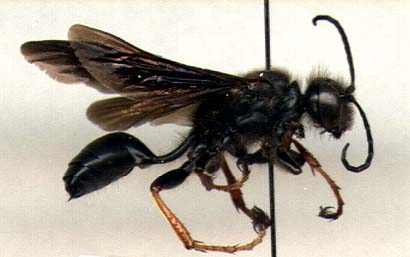Isodontia auripes (Fernald) 1906. This eastern U.S.
species ranges as far west as Kansas, south to Texas (Krombein 1979).
It is uncommon in Michigan, being restricted to the SLP.
BIOLOGY: Members of this genus are called the grass-carrying
wasps due to their habit of using grass blades to partition cells and
form closing plugs in their cavity nests. They are easily studied if
trap-nests (Krombein 1967) are used, such as lengths of bamboo, or
borings in wood placed in an open location. Isodontia auripes
nests contain a single large brood chamber in which several larvae
develop together (Krombein 1967, 1979). Krombein (1979) listed prey
as various species of Oecanthus, Orocharis, Orchelimum,
Neoxabea (Gryllidae); Conocephalus and Scudderia
(Tettigoniidae). It appears that gryllids, especially those in
the genus Oecanthus are most commonly taken.
FLOWER RECORDS: Melilotus alba.
COLLECTION DATES: 42 specimens, 3 July to 22 August, with most
dates in late July.

![]() BACK to Main Page
BACK to Main Page